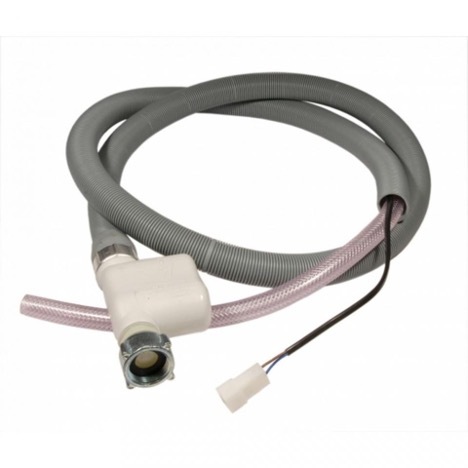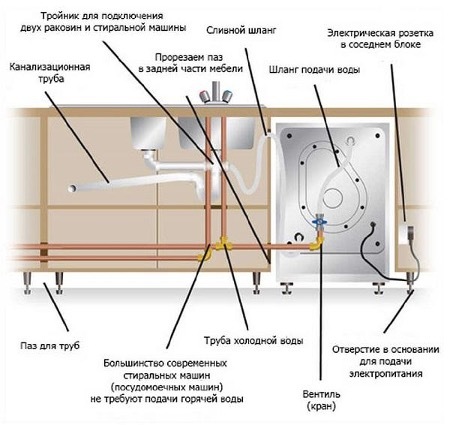Connecting the dishwasher to the water supply and sewerage can be done independently. There are several ways to do this - cut directly into the pipe or integrate the hose through the mixer. Step-by-step instructions and practical tips are described in the presented article.
The content of the article
- How to ensure a secure connection
- Which pipe is better to connect to
- Materials and tools
-
Step-by-step instructions for connecting
- The easiest ways
- Connection via mixer
- Pipe insert
How to ensure a secure connection
To properly connect the dishwasher to the water supply, you must consider 3 important safety requirements:
- When planning the placement, it should be borne in mind that the unit should stand at a distance of no more than 1.5 m from the sewer. The reason is not in the hoses, which can be made longer, but in the operation of the pump. You also need to understand that connecting the dishwasher to the sewer in the presence of excess connections can lead to leaks in one or more places.
- The outlet must be located at a sufficient height (at least 40 cm from the floor), because the device's network cable is rather short. It is desirable that the socket housing be made of moisture-resistant materials. If there is no separate outlet, it is better to install one. Connecting the device through a surge protector or a tee is unacceptable.
- Connecting the dishwasher to the water supply can be done by hand, if you have the appropriate skills. It is important to ensure that the system is completely sealed to avoid flooding.

Which pipe is better to connect to
Connecting the drain of the dishwasher to the sewer is carried out by tapping into a common pipe. On the other hand, it is not always clear which water pipe to connect the inlet hose to. There are 2 options - hot and cold water.
Moreover, in most cases, the dishwasher is connected to the water supply exactly to the cold pipe (such a requirement is written in the instructions). There are quite a few reasons:
- Hot water contains quite a lot of additives and other impurities, including lime and rust. They spoil the filters, the inlet hose and the drain system.
- Hot water is turned off much more often than cold water, including for a long period (1-2 weeks) during the preparation of the heating system for winter.
- Connecting the PMM to the sewer and cold pipe is also due to the fact that the optimum temperature during washing should be in the range of 40-60 degrees. In a hot pipe, it can be much higher (70-80), especially in winter. It will not be possible to reliably determine the temperature level, since no one regulates it.
- Due to the high temperature, the sewer pipe under the dishwasher will not suffer, since it is adapted for hot water. But due to exposure to high temperatures, the ion exchanger can fail. This device softens the water and plays a very important role. If it stops working, the heating element and other parts will gradually wear out.
Materials and tools
The conclusion of the sewer under the dishwasher can be done with your own hands, even with a minimum skill. To do this, you need to purchase some spare parts:
- flow filter to prevent clogging of the mesh and inlet hose; it also helps protect the non-return valve in the dishwasher;
- FUM tape;
- hoses and adapters (if the length of the hose included in the basic kit is not enough);
- a tee (0.75 inch thread) made of bronze or brass (this is the most durable option); the part must be equipped with a shut-off type valve;
- clamps - along with self-tapping screws, these can be special clamps and dowels;
- you can also purchase an aquastop hose, which will protect against leaks better than the regular part that comes with the kit.

When planning to connect the dishwasher to the siphon, you should prepare the tools at hand:
- a set of screwdrivers (curly, regular);
- wrench;
- pliers;
- building level.
Step-by-step instructions for connecting
There are several ways to connect the unit to the sewer. If there are outlets for the dishwasher, you can simply embed the hose into the sewer pipe. You can also bring it to the sink siphon. This and other methods are described below.
The easiest ways
There are several simple ways to connect a dishwasher to a pipe:
- If there is a free outlet, the unit can be connected directly to it. Moreover, the height of the drain for the dishwasher should be at least 40 cm relative to the floor surface. This will reliably protect the camera from the penetration of foreign odors into it.

- The drain hose is integrated into the siphon fitting. Some models come with 2-3 or more fittings. But if the already installed siphon does not have a free fitting, you must first purchase another siphon. Next, a drain hose is connected to it, and the waste liquid will go directly into the sewer.

- Do-it-yourself connection of the dishwasher to the sewer is often carried out already in the presence of a washing machine, which is also located in the kitchen. In such cases, a tee must be placed between the sewer pipe and the siphon. At 2 outlets, drain hoses of both devices are connected - PMM and washing machine.

Connection via mixer
Dishwasher outlets are easy to integrate with the sewer through a mixer. To do this, they act like this:
- Shut off the valve.
- Unscrew the hose leading to the mixer from the fittings to the pipe.
- Put the tee together with the tap.
- Connect the mixer hose to one of the outlets, put the unit hose and the flow filter to the other.
- Install a non-return valve on the drain of the dishwasher.
- Wrap the FUM tape on the thread. Sealing is carried out carefully, making at least 10 turns.

Pipe insert
If the unit is next to the pipe, installation is even easier. The sequence of actions is as follows:
- Close the inlet hose.
- With the help of a grinder, the pipe is cut off, the squeezing sleeve is mounted.
- A ball valve is screwed to it.
- A hose of the unit is wound onto its outlet.
- They seal the thread when connecting the dishwasher (for this, use the FUM tape).
Thus, the connection method depends on how far the device is located from the sewer pipe. In any case, you need to stir the PMM so that it is close enough (up to 1.5 m). Thanks to this, the unit will work for a long time, and the pump will not fail ahead of time.


